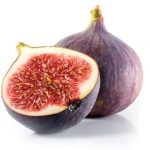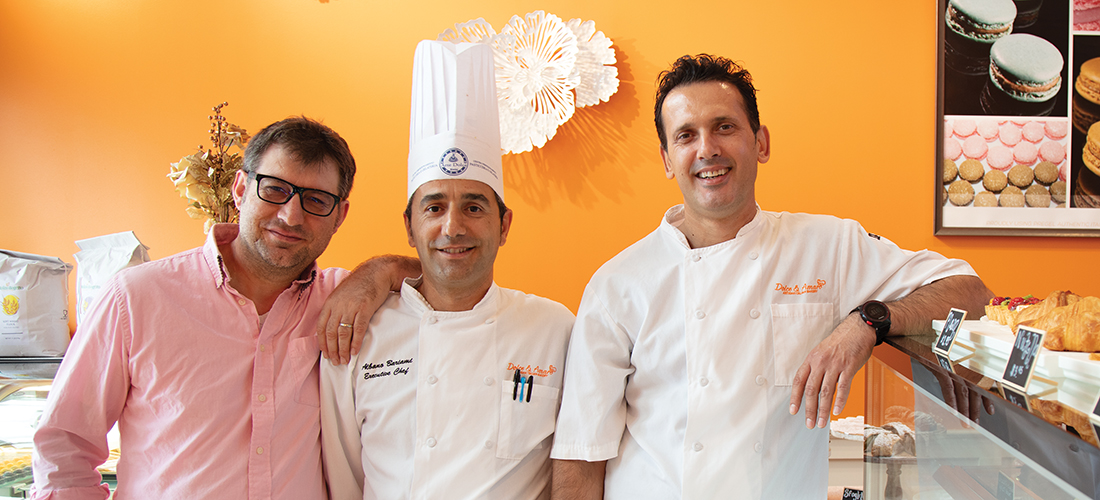
Dolce & Amaro is more than just a pastry shop. It’s the chance of a lifetime
By Nancy Oakley • Photographs by Mark Wagoner
What’ll it be? One of the dainty macarons in shades of pink and yellow or the bluish-purple cloud of cheesecake bearing a crown of fresh blueberries? How about a perfectly rounded puff coated with chocolate so shiny it would look just as at home displayed in a museum? Maybe a savory is the way to go — a salty croissant, whose delicate layers crackle and crumble at first bite. Or, you could answer the siren call of miniature pana cottas — vanilla cream, caramel and chocolate — standing sentry in a tray. Fantastical cakes beckon — one consisting of nutella and Chantilly covered in bright green pistachio icing with maraschino cherries on top, another, the “Marilyn Monroe” topped with bright pink lips. These visions of sugarplums — edible works of art — are staples at Dolce & Amaro Artisan Bakery, (which translates to, you guessed it, “sweet and savory”) tucked inside the Westover Gallery of Shops on Westover Terrace. But to the three men behind it, the operation, which opened last fall, is considerably more than a bakery; it is the culmination of a vision and an expression of their love of community.
“Together we have 75 years’ experience in the industry,” says Mikel Leka, the patisserie’s manager. “We” refers firstly to his cousin, Koco Tamburi, proprietor of nearby Osteria, which since 2013 has sated many an appetite with signature fare of Italy’s northeast Emilia-Romagna region and extensive wine list, and Embur Fire Fusion on Smyres Place, specializing in wood-fired pizzas with a Latin flair.
But what would an artisanal bakery be without a pastry chef? Rounding out the trio is the most recent transplant to the Gate City, Albano Barjami, the creative force behind Dolce & Amaro’s jewel-like confections.
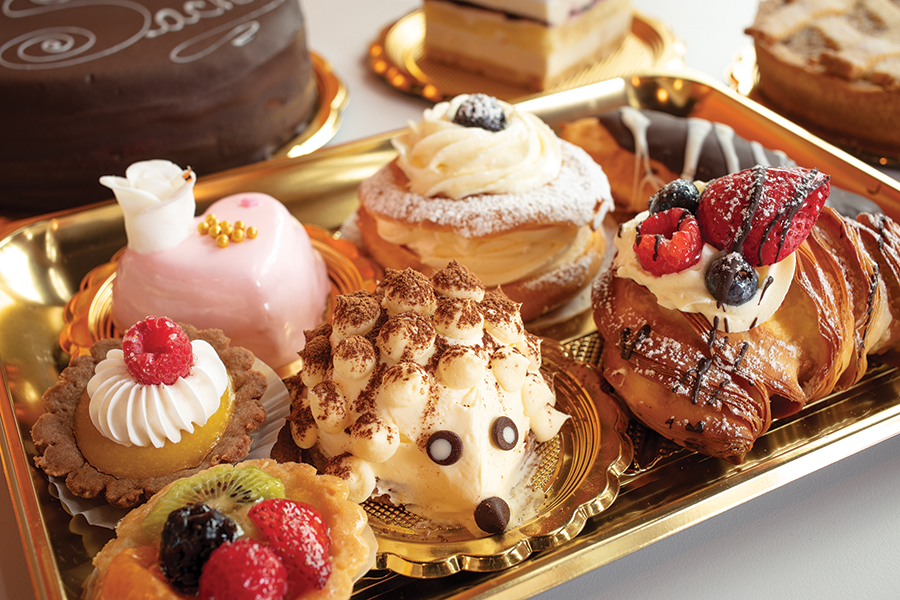
Growing up together in Emilia-Romagna’s famed resort town of Rimini on the Adriatic coast, the three amici worked in various capacities in the food and hospitality industry, putting in long days during the summers. Come winter, when the tourist season slowed to a halt, they dreamed of another life, of opening their own place together.
Little did they expect their dream would take 28 years to achieve.
Tamburi worked around Europe, his last stint being in London, before he struck out for Miami in 2001. Years later, when his wife was offered a job with a local pharmaceutical company, Tamburi was all for a move. At the time, just after the financial crisis of 2008, “the food scene here was not what it is now,” Tamburi recalls. He instinctively sensed opportunity and began encouraging his compatriots to join him.
Leka’s trajectory was similar, with stints in Miami, then in New York and owing to his wife’s career move, Charlotte, where he managed a group of restaurants. “It is good to follow the woman!” Tamburi quips. Barjami, meanwhile, had been honing his chops, working with some of the rock stars among Europe’s pastry chefs — Rossano Vinciarelli, Leonardo di Carlo, Luigi Biasetto, Antonio Guerre— teaching at international exhibitions, and becoming certified in the art of preparing “biologica” pastries.
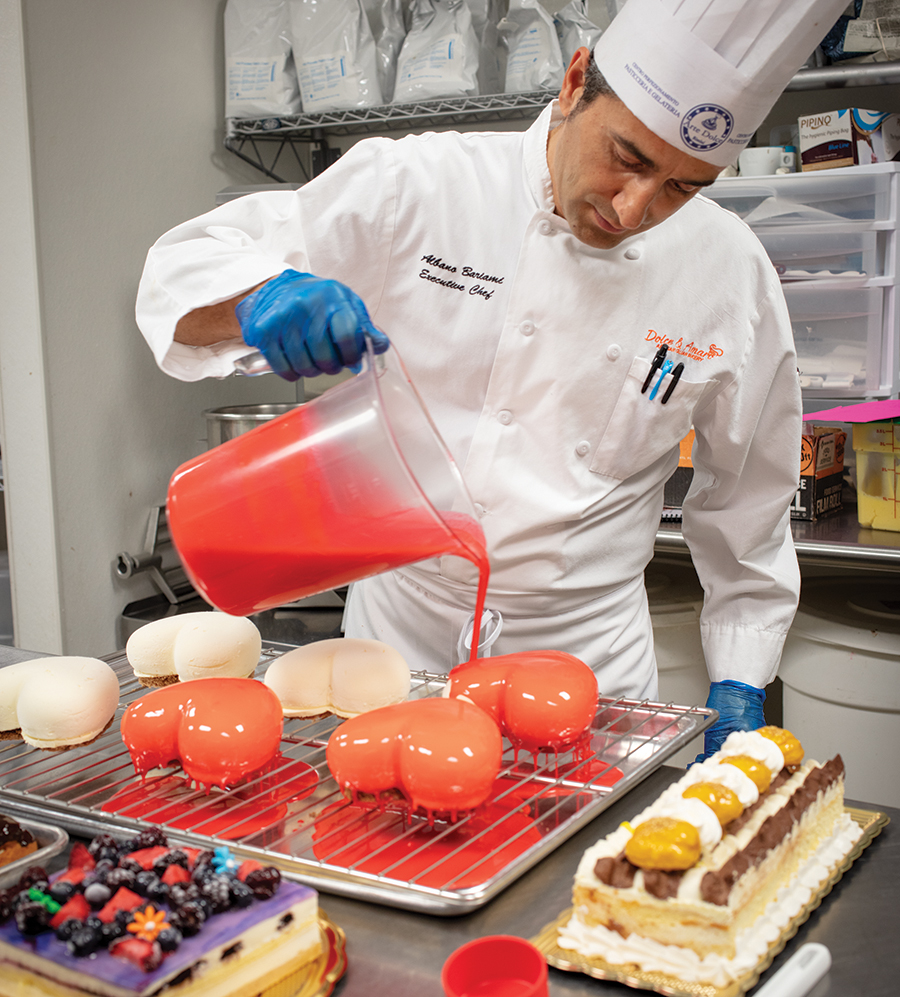
Loosely translated as “organic,” it carries specific implications that its American counterpart (often a marketer’s catchall phrase) does not. As in, mandatory three years’ training to become a certified “bio” chef, and tightly restricted ingredients. But having jumped through the rigorous culinary hoops in his native country, Barjami is able to whip up sugar- and gluten-free — and utterly delicious — options. The tantalizing macarons, for example, are made with almond flour. Other sweet treats might contain barley malt or rice flour. Glazes are derived from concentrated fruit. He explains that it’s tough to get the proper consistency for the items, some of them taking as long as two weeks to prepare. “It’s a constant balance,” he says to avoid pastries that taste like cardboard. Given their short shelf life, diners with special dietary needs will have to order the pastries in advance (though there are always sugar-free biscotti in one of the bakery’s cases).
But if you’re not among the gluten- or sugar-free crowd, then feel free to indulge without too much guilt, because, as Tamburi allows, “Here, flavor is First Place, not the sugar.” Sure enough, a Pateria Napoletana, a traditional Napolese Easter pastry consisting of wheat, egg, ricotta, orange-flower water, lemon and bits of candied fruit gradually unfolds on the tongue, revealing each component — tasting notes in a symphony, as it were. One reason Barjami’s pastries are so flavorful? “We don’t want to sacrifice integrity for taste,” Tamburi allows. So, they import as many ingredients as possible. “Pistachios . . . the best in the world are from Sicily,” he continues. Butter comes from Normandy. For the chocolate éclairs and other items, only 87 percent cocoa will do. Molina Colombo flour, which isn’t overly processed. “We are what we eat, we believe, and if we eat something valuable, beautiful, approachable . . . definitely, we are going to be a better person,” he says. He also applies his philosophy to the menus of Osteria, giving diners healthier options with imported authentic Italian ingredients.
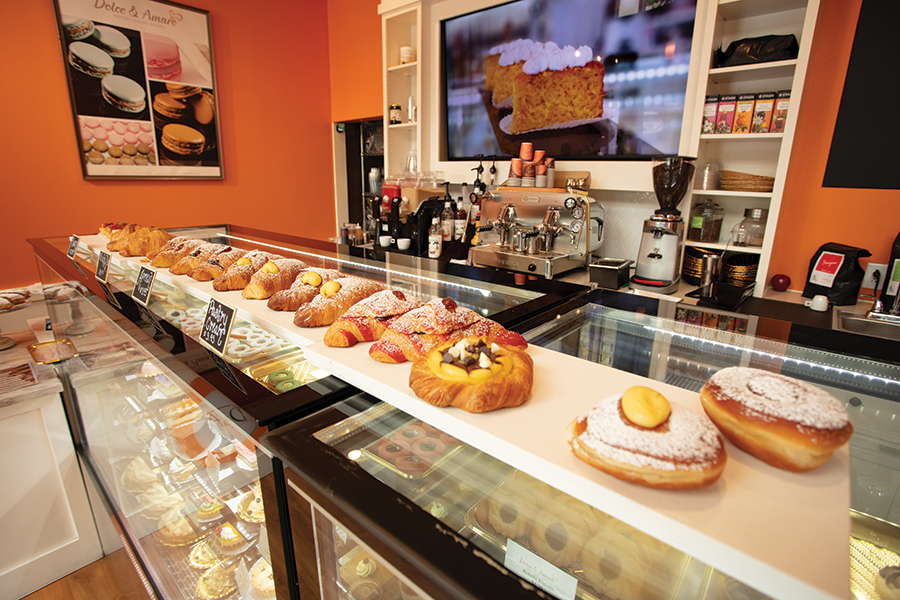
That sense of community is the beating heart of Dolce & Amaro, where Tamburi hails a couple of customers who’ve stopped in for cappuccino and brioche. Barjami is ever experimenting, blending culinary traditions of his native home with others, from a tiramisù cheesecake containing ricotta and cream cheese, to the French-inspired éclairs and brioches the bakery’s clientele have come to appreciate. Tamburi describes the offerings as “modern,” rather than regional, flashing a series of photos on his smartphone from a recent food expo in Milan to prove his point: The sleek, colorful, sculptural tarts of Sal de Riso, Italy’s top patisserie, look as though they were plucked from Dolce & Amaro’s display cases.
Even so, customers frequently come in, looking for sfogliatella or babà au rhum — not part of the original concept, as Leka discovered when the bakery opened last fall. “They were like, ‘What is an Italian bakery without sfogliatella?’ But pastry evolves like anything else, you know?” He shrugs while casting a glance at the case that contains, yes, the popular signatures of Naples, and a few rows over, some treats made of — what’s this? Peanut butter?
The customer is always right, as Tamburi, who knows Southern palates all too well, acknowledges. “We have to listen,” he says. “That is why a man has two eyes and one mouth.” The better to spread love — sealed with the “kiss” on a Marilyn Monroe cake. OH
Info: dolceamaroartisanbakery.com
Nancy Oakley, the senior editor of O.Henry.


